As data centers continue to grow in size and complexity, organizations are increasingly turning to artificial intelligence (AI) to address the challenges of scalability.
By implementing AI-powered data center operations, companies can benefit from automated and enhanced management aspects that optimize resource allocation, workload management, and capacity planning.
Leveraging machine learning algorithms and predictive analytics, real-time data can be analyzed to gain valuable insights, leading to improved operational efficiency, reduced costs, and enhanced customer satisfaction.
AI also plays a crucial role in enhancing security by detecting anomalies and potential breaches while optimizing resource allocation based on workload demands.
The benefits of implementing AI in data center operations are vast, and organizations are finding that it enables scalability for the future.
But how exactly does AI achieve these outcomes? Let's explore the key AI-powered strategies and techniques that are reshaping data center scalability.
Key Takeaways
- AI-powered solutions enable data centers to handle increasing workloads efficiently and cost-effectively.
- AI-driven resource allocation ensures optimal utilization of computing power and storage resources based on workload demands.
- Implementing AI leads to improved operational effectiveness, cost efficiency, and scalability in data centers.
- By analyzing historical data and real-time insights, AI and machine learning algorithms can accurately predict future resource demands, minimizing revenue loss due to service disruptions.
AI-powered Predictive Maintenance
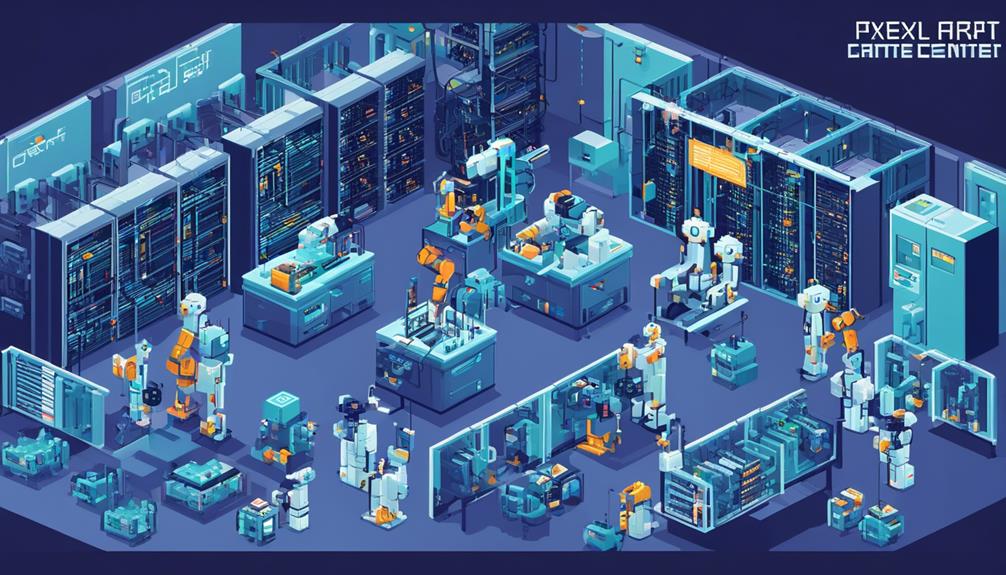
Utilizing machine learning algorithms, AI-powered predictive maintenance anticipates and prevents equipment failures in data centers, ensuring efficient resource allocation and workload management while optimizing overall performance. By analyzing real-time data, AI-based solutions can proactively identify potential issues before they result in downtime, minimizing operational costs and maximizing data center efficiency.
Implementing AI-powered predictive maintenance in data centers has significant benefits for resource management. By continuously monitoring the condition of equipment, AI algorithms can predict when maintenance is required, allowing for better planning and allocation of resources. This proactive approach avoids unnecessary downtime and ensures that maintenance tasks are performed at the most optimal times, reducing the impact on workload management.
Furthermore, AI-powered predictive maintenance enables data centers to operate with enhanced efficiency. By analyzing historical and real-time data, machine learning algorithms can identify patterns and trends in equipment behavior, allowing for the prediction of potential failures. This information can then be used to optimize energy consumption and improve energy efficiency, leading to cost savings and a reduced environmental footprint.
In addition to improving efficiency, AI-based predictive maintenance also enhances data center scalability. By identifying potential vulnerabilities and anomalies in the system, AI algorithms can help prevent security breaches and ensure data integrity. This proactive approach to security safeguards sensitive information and protects against potential threats, allowing data centers to scale without compromising security measures.
Energy Optimization Strategies
Energy optimization strategies in data centers involve various techniques such as power usage monitoring and thermal management.
Power usage monitoring allows for real-time tracking of energy consumption, enabling data center operators to identify areas of high energy usage and implement measures for optimization.
Thermal management techniques, on the other hand, focus on optimizing cooling systems to ensure efficient heat dissipation and reduce energy consumption.
Power Usage Monitoring
Through the implementation of AI and ML algorithms, data centers can effectively monitor power usage to optimize energy consumption and improve operational efficiency. Power usage monitoring is a crucial aspect of energy optimization strategies in data centers. By tracking and analyzing power usage effectiveness, data center operators can identify areas of high energy consumption and implement measures to optimize resource allocation. Machine learning algorithms can analyze historical data and patterns to predict power usage trends, enabling proactive measures to minimize energy wastage. Additionally, power usage monitoring helps identify inefficient equipment or cooling systems, leading to potential cost savings on cooling costs. An AI-enabled data center can continuously monitor and adjust power usage, ensuring optimal energy consumption while reducing environmental impact. The table below summarizes the benefits of power usage monitoring in data centers.
| Benefits of Power Usage Monitoring |
|---|
| Optimizes energy consumption |
| Improves operational efficiency |
| Reduces cooling costs |
Thermal Management
With a focus on energy optimization and efficient cooling systems, thermal management strategies play a crucial role in maximizing data center efficiency and minimizing environmental impact. Implementing AI algorithms and predictive analytics enables intelligent data analysis to optimize resource allocation and enhance energy efficiency in data centers.
Here are four key aspects of thermal management in data centers:
- Real-time monitoring and maintenance: AI algorithms analyze historical and real-time data to identify potential issues in cooling systems, allowing proactive maintenance and minimizing the risks of downtime and disruptions.
- Energy-efficient configurations: AI analysis identifies energy wastage and suggests energy-efficient configurations for cooling systems, reducing overall energy consumption.
- Automating resource allocation: AI algorithms automate tasks such as resource allocation and capacity planning, optimizing cooling system usage and reducing operational costs.
- Cooling system optimization: AI-driven predictive analytics enables data centers to optimize cooling system performance based on real-time metrics, ensuring efficient temperature control and energy utilization.
Enhancing Data Center Security With AI
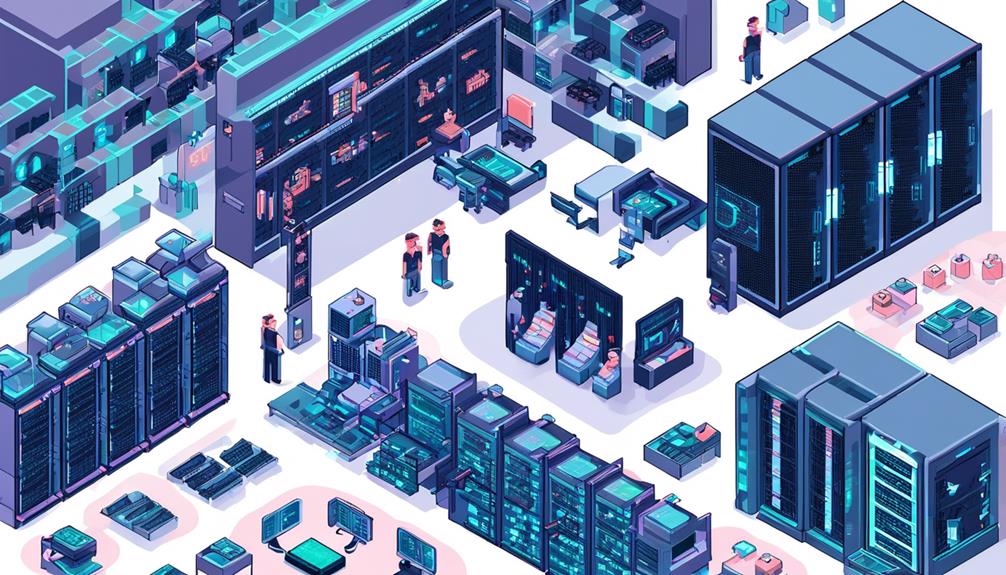
Enhancing data center security with AI involves leveraging AI-driven threat detection, automated access control, and real-time anomaly detection.
AI can analyze vast amounts of data to identify patterns and detect potential security threats, allowing for proactive measures to be taken.
Automated access control systems can use AI algorithms to verify user identities and ensure only authorized personnel gain access to critical areas.
Real-time anomaly detection can continuously monitor network traffic and system behavior, quickly identifying any deviations from normal operations and enabling immediate response to potential breaches.
Ai-Driven Threat Detection
AI-driven threat detection in data centers utilizes machine learning algorithms to analyze network traffic in real-time, allowing for proactive identification of potential breaches and security threats. This approach brings numerous benefits to data centers, enhancing both security measures and operational efficiency.
Here are four key ways AI-driven threat detection improves data center security:
- Real-time monitoring: AI algorithms continuously monitor network traffic, promptly detecting any anomalies or suspicious activities that may indicate a security breach.
- Automated threat response: AI can automatically respond to identified threats by implementing mitigation measures, such as isolating affected systems or blocking suspicious traffic, minimizing the impact of potential breaches.
- Enhanced accuracy: AI algorithms learn from historical data, improving their ability to accurately differentiate between normal and abnormal network behavior, reducing false positives and false negatives.
- Scalability: AI-driven threat detection can easily scale to handle large volumes of data, ensuring that data centers can effectively protect their infrastructure as their operations grow.
Automated Access Control
Automated Access Control in data centers leverages advanced AI algorithms to optimize resource allocation, workload management, and capacity planning, enhancing overall security measures and operational efficiency.
By implementing AI-powered security solutions, data centers can enhance their ability to detect and prevent unauthorized access. AI algorithms analyze network traffic patterns, allowing for the identification of security threats and potential breaches. This helps in reducing the risk of unauthorized access and improving data center security.
Additionally, AI-based systems can detect anomalies and potential breaches, further enhancing overall security.
Automated Access Control also plays a crucial role in optimizing resource allocation and workload management, enabling data centers to operate more efficiently. By leveraging AI and ML technologies, data centers can achieve higher scalability, reduce operational costs, and enhance the efficiency of their operations.
Real-Time Anomaly Detection
Real-Time Anomaly Detection leverages advanced AI algorithms to continuously monitor data center operations, quickly identifying any abnormal behavior or potential security threats. This technology plays a crucial role in enhancing data center security by analyzing network traffic patterns and system behavior in real-time.
Here are four key benefits of implementing Real-Time Anomaly Detection in data centers:
- Proactive threat detection: AI algorithms can analyze vast amounts of data to flag anomalies and potential breaches, allowing organizations to proactively detect and respond to security threats.
- Enhanced security posture: By providing real-time insights and automated responses to potential security incidents, Real-Time Anomaly Detection enhances the overall security posture of data centers, protecting critical data and infrastructure.
- Reliable operations: AI-powered Real-Time Anomaly Detection ensures the integrity and reliability of data center operations by continuously monitoring and alerting any abnormal behavior.
- Optimize resource utilization: By identifying anomalies in data center workloads, AI and ML solutions can optimize cooling and energy usage, leading to improved resource utilization and cost savings.
Efficient Resource Allocation Techniques
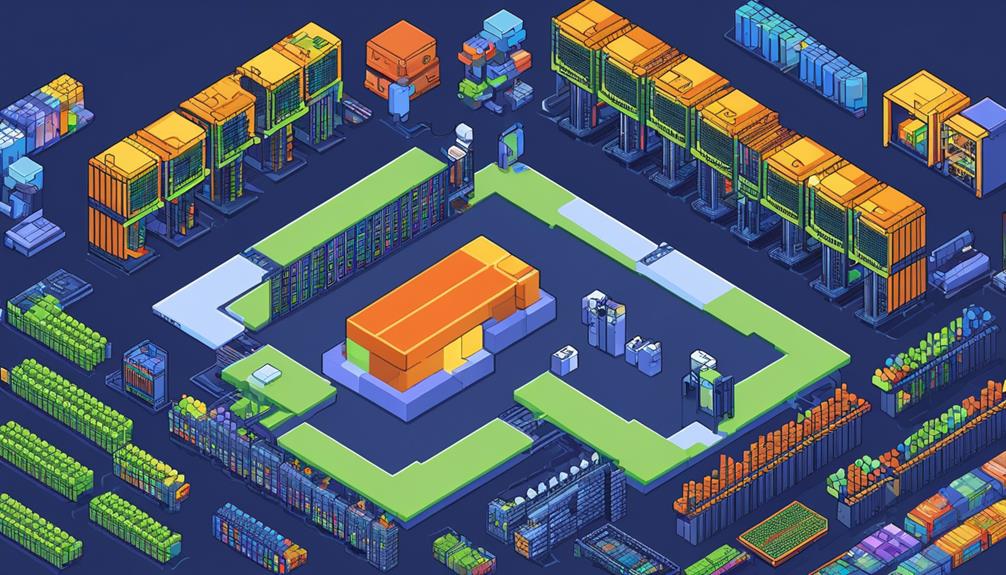
Efficient resource allocation techniques play a crucial role in optimizing workload management and capacity planning in data centers. Implementing AI models and machine learning algorithms can provide valuable insights to improve resource allocation and workload management. By analyzing historical data and patterns, these AI-driven algorithms can identify the most efficient ways to allocate computing resources based on workload demands.
One of the key benefits of efficient resource allocation techniques is the ability to automate routine tasks. AI models can analyze the workload demands in real-time and dynamically allocate computing resources accordingly. This automation not only saves time but also ensures that resources are utilized optimally, leading to improved operational efficiency and reduced costs in data center operations.
Predictive analytics and AI-driven algorithms also play a vital role in dynamic resource allocation. By continuously monitoring the workload demands and predicting future resource requirements, these techniques enable data centers to allocate resources proactively. This proactive approach helps in avoiding bottlenecks and ensures that computing resources are available when needed, ultimately enhancing overall data center performance and customer satisfaction.
Moreover, efficient resource allocation techniques enable data centers to scale their operations effectively. As the demand for computing resources fluctuates, these techniques ensure that resources are allocated efficiently, allowing data centers to handle increasing workloads without compromising performance or incurring unnecessary costs.
Intelligent Automation for Data Centers
Integrating artificial intelligence (AI) into data center operations revolutionizes management functions, delivering enhanced automation and cost reduction. By leveraging machine learning algorithms and predictive analytics, data centers can optimize resource allocation, workload management, and capacity planning based on real-time data analysis. This intelligent automation brings numerous benefits to data center operations, improving efficiency and reducing costs.
To further illustrate the advantages of intelligent automation in data centers, here are four key points:
- Enhanced Resource Utilization: AI-powered systems can dynamically allocate computing resources based on demand, ensuring optimal utilization without compromising performance. This allows data centers to efficiently handle fluctuating workloads and avoid overprovisioning, saving energy and costs.
- Intelligent Cooling: AI algorithms can analyze temperature patterns and airflow in data centers, enabling proactive cooling management. By adjusting cooling systems in real-time, AI can optimize energy consumption and maintain the ideal temperature for server operation, reducing cooling costs.
- Predictive Maintenance: Machine learning algorithms can analyze vast amounts of data to predict equipment failures and schedule maintenance activities. By identifying potential issues before they become critical, data centers can minimize downtime, increase equipment lifespan, and reduce maintenance costs.
- Automated Operations: AI can automate routine tasks in data center operations, such as monitoring, alerting, and incident management. This reduces the need for manual intervention, allowing personnel to focus on more strategic initiatives. Automated decision-making also improves response times, minimizing the impact of potential issues and enhancing customer satisfaction.
Intelligent automation powered by AI and machine learning solutions is becoming increasingly prevalent in data center operations. Organizations are experiencing improved resource utilization, reduced energy consumption, lower maintenance costs, and enhanced operational effectiveness. As a result, more data center operators are embracing AI-based solutions to optimize their operations and achieve scalability while ensuring cost efficiency.
Cost Reduction Methods With AI
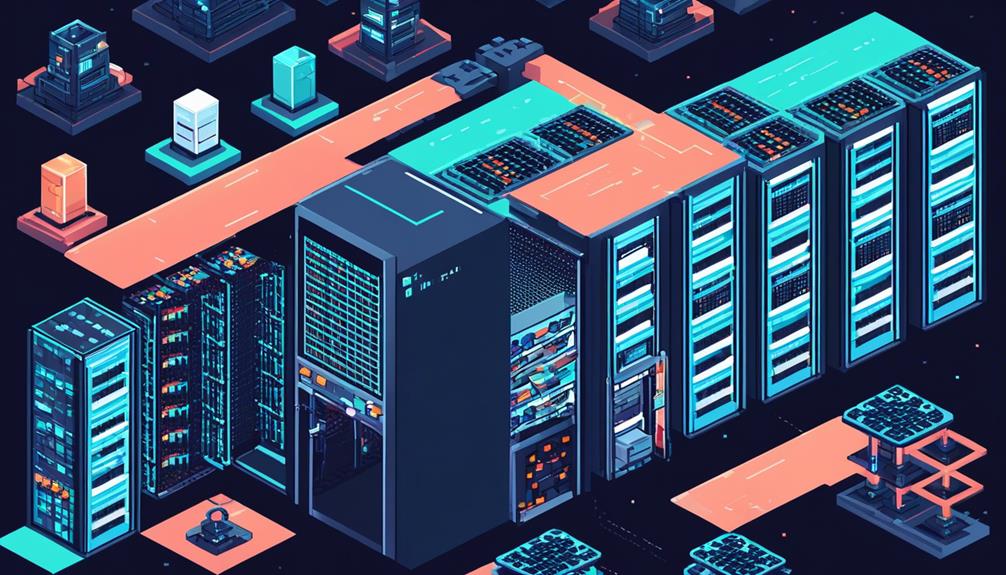
AI-powered solutions offer effective strategies for reducing costs in data centers by streamlining procedures, enhancing energy efficiency, and optimizing resource allocation. Implementing AI for cost reduction in data centers involves leveraging machine learning algorithms and analytics to improve operational efficiency and energy management.
One of the key ways AI reduces costs is by automating and improving management functions. By utilizing AI-powered operations, data center operators can cut expenses and increase operational effectiveness. This includes automating routine tasks, such as system monitoring and maintenance, which reduces the need for manual intervention and associated labor costs.
AI and machine learning algorithms also play a crucial role in optimizing resource allocation, workload management, and capacity planning. By analyzing historical data and real-time information, AI algorithms can identify patterns and trends, allowing for more accurate predictions and proactive decision-making. This optimization leads to better utilization of resources, reducing waste and unnecessary expenses.
Furthermore, AI in data centers improves energy efficiency, which is a significant cost factor. AI-powered systems can analyze energy consumption patterns and identify opportunities for optimization. This includes dynamically adjusting cooling and power distribution based on workload demands, thereby reducing energy waste and lowering electricity costs.
Implementing AI for cost reduction in data centers also improves customer satisfaction. AI-powered solutions enable faster response times and automated decision-making, leading to enhanced service quality and reduced downtime. This, in turn, contributes to cost reduction by minimizing revenue loss due to service disruptions.
Scalability and Flexibility Improvement
Scalability and flexibility improvement in data centers is crucial for adapting to changing workloads and resource demands while maintaining optimal operational efficiency. Implementing AI-based solutions can greatly enhance the scalability and flexibility of data center operations. Here are four key ways in which AI can improve data center scalability and flexibility:
- Optimized resource allocation: AI and machine learning algorithms can analyze historical data and real-time insights to predict future resource demands. By intelligently allocating computing power and storage resources, data centers can scale up or down based on workload requirements, ensuring efficient resource utilization.
- Workload management: AI algorithms can dynamically distribute workloads across servers and networks, optimizing performance and minimizing bottlenecks. This enables data centers to handle increased workloads without compromising on speed or reliability.
- Predictive maintenance and energy optimization: AI can analyze sensor data and identify patterns that indicate potential equipment failures. By predicting maintenance needs, data centers can schedule proactive repairs, reducing downtime and improving overall flexibility. Additionally, AI can optimize energy usage by identifying opportunities for energy conservation, leading to cost savings and improved operational efficiency.
- Enhanced security: AI-based security solutions can detect and prevent cyber threats in real-time. By continuously monitoring network traffic and analyzing patterns, AI can identify potential vulnerabilities and proactively mitigate risks. This ensures a flexible and secure data center environment, safeguarding sensitive data and maintaining business continuity.
Incorporating AI into data center operations not only improves scalability and flexibility but also enhances the overall efficiency of data processing. With intelligent automation, reduced costs, and optimized resource utilization, organizations can achieve greater operational agility and adaptability, meeting the evolving demands of modern business environments.
Effective Capacity Planning With AI

Effective capacity planning is crucial for data centers to ensure optimal resource utilization and cost efficiency.
AI plays a vital role in this process by leveraging advanced algorithms to analyze historical data, predict future demand, and intelligently forecast capacity requirements.
AI for Scalability Optimization
Utilizing advanced AI algorithms and predictive analytics, data centers can achieve optimal scalability by efficiently planning and allocating resources based on real-time data analysis. Implementing AI for scalability optimization offers several benefits to data center operators.
- Enhanced resource allocation: AI applications utilize machine learning algorithms to analyze real-time data and make informed decisions about resource allocation. This ensures that resources are efficiently utilized, leading to improved performance and reduced costs.
- Improved capacity planning: By leveraging AI and machine learning, data center operators can accurately forecast future demand and plan their capacity accordingly. This helps prevent overprovisioning or underutilization of resources, leading to cost savings and improved efficiency.
- Automated scalability: AI-based solutions can automatically scale resources up or down based on workload demands. This dynamic scalability ensures that the data center can handle fluctuating workloads without compromising performance or incurring unnecessary costs.
- Efficiency with power consumption: AI algorithms can optimize power usage by analyzing data center operations and identifying opportunities for energy efficiency. This not only reduces power consumption but also lowers operational costs and contributes to environmental sustainability.
Intelligent Capacity Forecasting
With the implementation of AI algorithms and predictive analytics, data centers can achieve efficient capacity planning through intelligent forecasting, optimizing resource allocation based on real-time data analysis. This enables data centers to effectively scale their operations to meet the increasing workload demands and ensure the efficiency of the data center.
Intelligent capacity forecasting leverages AI-based solutions to analyze the volume of data generated by the data center and predict future resource requirements. By considering factors such as historical data, system performance, and workload patterns, AI algorithms can accurately forecast the capacity needed to handle future demands.
To illustrate the benefits of intelligent capacity forecasting, consider the following table:
| Benefits of Intelligent Capacity Forecasting |
|---|
| Improved resource allocation |
| Enhanced scalability and flexibility |
| Optimized data center performance |
AI-based Predictive Analytics Tools
AI-based predictive analytics tools harness the power of machine learning algorithms to accurately forecast future trends and provide critical insights for decision-making in data center operations. These AI-based solutions are revolutionizing the way data centers operate by enabling smarter, more efficient processes. Here are four key benefits of using AI-based predictive analytics tools in data centers:
- Intelligent Cooling and Energy Management:
AI-powered tools enable data centers to optimize their cooling and energy management systems. By analyzing historical data and real-time information, these tools can predict cooling requirements and adjust energy consumption accordingly. This not only ensures efficient operations but also helps reduce energy costs and environmental impact.
- Autonomous Monitoring and Maintenance:
AI-based predictive analytics tools facilitate autonomous monitoring and maintenance of data center infrastructure. These tools continuously analyze data from various sensors and devices to detect anomalies and potential issues. By identifying problems before they occur, data center operators can take preventive measures, minimizing downtime and improving overall reliability.
- Optimized Workload Management:
Intelligent workload management platforms leverage AI to optimize resource allocation based on workload demands. These tools analyze historical data, user patterns, and workload characteristics to allocate resources efficiently. By dynamically adjusting resource allocation, data centers can maximize utilization and improve operational efficiency.
- Automated Provisioning and Configuration Management:
AI-based predictive analytics tools automate resource provisioning and configuration management. By leveraging machine learning algorithms, these tools can automatically set up and configure resources based on predefined rules and policies. This streamlines operational processes, reduces manual effort, and ensures consistent and error-free configurations.
Intelligent Cooling and Energy Management

Integrating advanced AI-driven technologies into data center operations, the focus now shifts to the vital subtopic of intelligent cooling and energy management, where cutting-edge algorithms optimize cooling systems and energy consumption for enhanced efficiency and reduced environmental impact. AI-based solutions in this domain use machine learning algorithms to analyze real-time data and identify energy wastage, allowing data centers to make data-driven decisions for improving energy efficiency and reducing costs.
One of the key advantages of intelligent cooling and energy management systems is their ability to optimize cooling systems. By continuously monitoring temperature and airflow patterns, AI algorithms can identify inefficiencies and suggest adjustments to optimize cooling performance. This not only improves energy efficiency but also helps prolong the lifespan of cooling equipment by reducing unnecessary strain.
To better illustrate the benefits of intelligent cooling and energy management in data centers, consider the following table:
| Advantages of Intelligent Cooling and Energy Management |
|---|
| Improved energy efficiency through optimized cooling performance |
| Reduced environmental impact through reduced energy consumption |
| Lower operational costs due to minimized energy wastage |
| Enhanced equipment lifespan through proactive maintenance and optimized cooling systems |
Autonomous Monitoring and Maintenance
Autonomous monitoring and maintenance systems in data centers harness the power of AI to detect anomalies and proactively initiate preventive measures. These systems play a crucial role in automating and streamlining maintenance functions, leading to reduced operational costs and improved efficiency.
Here are four key aspects of autonomous monitoring and maintenance in data centers:
- Real-time anomaly detection: AI algorithms continuously analyze real-time data from various sources within the data center, such as temperature sensors, power usage monitors, and server logs. By comparing this data against historical patterns and predefined thresholds, AI can quickly identify anomalies that may indicate potential issues, such as abnormal temperature fluctuations or power spikes.
- Proactive maintenance: Once an anomaly is detected, AI systems can autonomously initiate preventive measures to address the issue before it escalates into a critical problem. For example, if a cooling system is not functioning optimally, AI can adjust the airflow or notify maintenance personnel for timely intervention, preventing overheating and potential equipment failures.
- Workload optimization: Autonomous monitoring and maintenance solutions leverage machine learning techniques to optimize resource allocation and workload management. By analyzing performance data and workload patterns, AI can dynamically adjust the allocation of computational resources, ensuring efficient utilization and minimizing bottlenecks.
- Capacity planning and infrastructure optimization: AI-powered systems can analyze historical data and predict future resource demands to facilitate effective capacity planning. By identifying potential capacity constraints in advance, data center operators can optimize infrastructure expansion or upgrade plans, ensuring scalability and avoiding costly downtime.
Implementing autonomous monitoring and maintenance systems in data centers can significantly enhance operational effectiveness and contribute to improved customer satisfaction. These systems continuously learn and adapt to shifting workload patterns, enabling proactive and efficient maintenance in the ever-evolving data center environment. By harnessing the power of AI, data centers can achieve higher scalability, better energy management, and increased infrastructure reliability.
Workload Management Platforms With AI
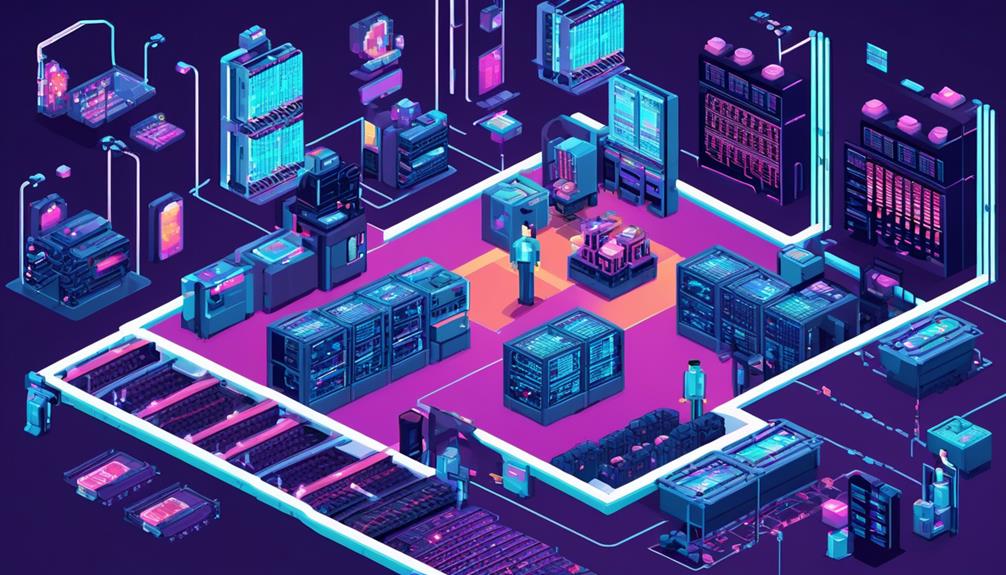
In the realm of data center scalability, the integration of AI extends beyond autonomous monitoring and maintenance systems to encompass workload management platforms that leverage machine learning algorithms and predictive analytics. These platforms play a crucial role in optimizing resource allocation and capacity planning within data centers, enabling organizations to implement efficient and effective workload management strategies.
By harnessing AI capabilities, workload management platforms can improve operational efficiency by automating and enhancing management tasks. This automation leads to reduced costs and improved resource utilization. With the insights gained from AI analysis, organizations can dynamically allocate computing power, storage, and network bandwidth based on workload demands. This flexible allocation ensures that resources are efficiently utilized and scaled as needed, leading to improved efficiency and scalability within the data center environment.
Moreover, AI in workload management platforms can aid in identifying potential security threats. By analyzing network traffic patterns and detecting anomalies in real-time, AI algorithms can quickly identify and mitigate security risks. This proactive approach to security enhances data center resilience and protects against potential breaches.
The implementation of AI in workload management platforms also brings additional benefits to organizations. Improved customer satisfaction, automated decision-making, and enhanced service quality are reported outcomes of leveraging AI capabilities in data center operations. With AI-powered workload management platforms, organizations can provide better and more efficient services to their customers, resulting in an overall improved user experience.
Frequently Asked Questions
What Are the Benefits of AI in Data Centers?
AI in data centers offers numerous benefits. These include predictive analytics for minimizing equipment failures and downtime, enhanced operational efficiency through real-time monitoring, automated resource allocation based on workload demands, improved energy efficiency for cost reduction and environmental impact, enhanced security measures to detect anomalies and potential breaches, faster troubleshooting and issue resolution, optimized workload distribution, and streamlined data management.
These advantages contribute to overall improved performance and scalability of data centers.
What Is Scalability in Data Center?
Scalability in data centers refers to the ability to efficiently handle increasing workloads and demands without compromising performance or reliability. It involves expanding resources such as computing power, storage, and networking capabilities to accommodate growing data and application needs.
Scalability strategies focus on optimizing resource allocation, workload management, and capacity planning to support business growth. It is essential in data center architecture to ensure seamless and cost-effective expansion or contraction of infrastructure.
Achieving scalability requires careful consideration of various factors, including cloud-based solutions, virtualization, and performance monitoring. Future trends include the integration of AI to enhance data center scalability.
Is the Process of Creating a Modern Data Center That Is Highly Scalable Available and Secure?
Creating a modern data center that is highly scalable, available, and secure requires careful consideration of various factors.
Ensuring data privacy, optimizing server utilization, reducing energy consumption, enhancing network performance, improving fault tolerance, streamlining resource allocation, automating workload management, enabling predictive maintenance, and enhancing data center security are all crucial elements.
What Data Would You Use With the AI Implementation?
In order to implement AI for data center scalability, a wide range of data would be utilized.
This includes real-time operational data from the data center, which provides insights into resource utilization, workload patterns, and energy consumption.
Historical data on equipment performance, failures, and maintenance is also utilized for predictive maintenance.
Network traffic data is crucial for AI to identify security threats and anomalies.
Additionally, data on customer feedback, operational costs, and performance metrics is employed for data analytics and machine learning algorithms to optimize resource utilization, perform fault detection, and enhance energy efficiency.
